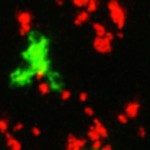Lien vers Pubmed [PMID] – 22720207
Oncoimmunology 2012 Jan;1(1):9-17
Treatment for non-muscle invasive carcinoma of the bladder represents one of the few examples of successful tumor immunity. Six weekly intravesical instillations of Bacillus Calmette-Guerin (BCG), often followed by maintenance schedule, result in up to 50-70% clinical response. Current models suggest that the mechanism of action involves the non-specific activation of innate effector cells, which may be capable of acting in the absence of an antigen-specific response. For example, recent evidence suggests that BCG-activated neutrophils possess anti-tumor potential. Moreover, weekly BCG treatment results in a prime-boost pattern with massive influx of innate immune cells (107-108 PMN/ml urine). Calibrating in vivo data, we estimate that the number of neutrophil degranulations per instillation is approximately 106-107, more than sufficient to potentially eliminate ~106 residual tumor cells. Furthermore, neutrophils, as well as other innate effector cells are not selective in their targeting-thus surrounding cells may be influenced by degranulation and / or cytokine production. To establish if these observed conditions could account for clinically effective tumor immunity, we built a mathematical model reflecting the early events and tissue conditioning in patients undergoing BCG therapy. The model incorporates key features of tumor growth, BCG instillations and the observed prime / boost pattern of the innate immune response. Model calibration established that each innate effector cell must kill 90-95 bystander cells for achieving the expected 50-70% clinical response. This prediction was evaluated both empirically and experimentally and found to vastly exceed the capacity of the innate immune system. We therefore conclude that the innate immune system alone is unable to eliminate the tumor cells. We infer that other aspects of the immune response (e.g., antigen-specific lymphocytes) decisively contribute to the success of BCG immunotherapy.





